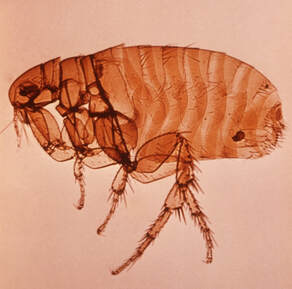
Species of Fleas are very problematic wildlife pests that can rapidly develop into an entire flea infestation if left unchecked. Flea species have a flattened shape, a coloration that is somewhere between dark brown and reddish-brown, and they are very small. There is also a human flea that has comb-like spines around its neck and mouth. These fleas can be discovered in every state in the United States. The cat flea is the most prevalent flea in North America, but it can also be found on dogs, people, and oriental rats. Fleas have a lifespan of about 100 days on average. The optimal environment for the year-round development of fleas is provided by homes with carpets and central heating. The flea’s life cycle can be finished in as little as two weeks under ideal conditions, but it can take up to a year under adverse condition. Around 500 flea eggs are produced by female fleas after having a good blood meal while they are in this state. Because of this, a single flea larva can quickly give rise to several hundred more fleas and the cycle of fleas continues. When a flea reaches the pupa stage, it can hibernate for several months until the appropriate circumstances allow the adult flea to emerge. It could take many weeks for the pupae stage fleas to moult. The source of cat flea infestations are extremely challenging for a single person to treat on their own. The larvae will consume organic debris, adult flea feces, and even the skin of your pets until the circumstances are ideal for them to pupate and spin a cocoon. Single adult fleas that have just hatched leap onto a host animal to finish their life cycle. That is why a professional pest control operator and professional pest control company who are experts on the stages of fleas shall call for assistance. Trying chemical pesticide products for wildlife pests and chemical flea treatments for flea killers are harmful not only to domestic animals or wild animals but primarily to humans. Some cats may be harmed by flea collars, and those that smell strongly of pesticides run the risk of causing a skin response or rash. Without flea and tick medicine, whether it be a topical therapy or a tablet, dogs and cats are susceptible to anything from tapeworms to flea allergy dermatitis, which causes your pet to bite, scratch, and occasionally lose hair. There should be a plan for smart pest program and rigorous flea control before using flea control products such as insect growth regulators or veterinarian-prescribed topical flea products to avoid bigger problems of a common flea.
Do fleas pose a health risk to humans?
Fleas cause flea-related diseases as they cause their hosts to lose blood, which can lead to anemia.
Fleas are known to provoke allergic reactions, itching, and scratching, which can lead to secondary infections. The flea bites can give flea-transmitted diseases such as cat scratch fever and plague through their flea bites. Although flea activity does not live on people, they will bite you multiple times if they come into contact with you. When adult fleas are absent, flea dirt can still be detected.
You cannot know that the fleas in your home do not carry diseases, even though not all fleas are known to spread illness. Fleas and bed bugs are probably the two insects that are the most annoying to humans. These tiny parasites can move from one place to another with relative ease and infest your home, thereby posing a threat to the health of your cherished cat and dog, and in some instances, to the health of your entire family! One species of tapeworm uses the flea as an intermediary host. By ingesting tapeworm eggs, flea larvae become infected, and if a cat swallows an infected flea during grooming, the tapeworm larva will mature into an adult tapeworm. This might lead to tapeworm infestation. When you first notice them, getting rid of them ought to be the very first thing on your list of priorities. You need to have a comprehensive flea inspection to find if there are flea eggs, pre-adult fleas or adult fleas living in your animal or home with environmental conditions.
The Elimination of Fleas and the Methods of Flea Control
You can do DIY elimination of fleas at home especially if the case is manageable but this method does not guarantee long-term prevention of fleas. This is especially true of flea shampoos and powders because they kill fleas on your cat at the time of application but have no long-term impact; the next day, the cat can have fleas once more. You can place a lamp overnight over a pan of soapy water to make an adult-flea trap at home. Your pet’s bedding should be either replaced or cleaned in hot water to get rid of the in addition to dead fleas. Once you have determined that you have an uninvited guest monster flea, you will need to take the appropriate steps to get rid of this flea activity in both your home and your pet by employing flea removal or flea traps and extermination methods. There are several over-the-counter products that can kill fleas in their adult, immature fleas and larval stages and halt flea life cycles. You can also do initial treatment by using flea control products and chemical flea treatment but make sure to consult a professional advice before using it.

The process of extermination and planning for flea control that is carried out by professionals involves a total of four stages.
Stage 1
Sanitation of the home like putting hot water is the first thing that needs to be done to get rid of fleas. Start by looking at your dog or cat’s skin and fur when you notice excessive scratching to see whether you actually have a flea infestation. Before beginning the actual extermination process or flea killers, professionals who specialize in flea control recommend giving the entire house a thorough cleaning and vacuuming. Your home likely has a lot of these flea hot spots, so it’s critical to identify and treat them all. However, this can be a challenging task, so keep in mind that it is most important to concentrate on areas that receive a lot of foot traffic. It is important to pay close attention to the carpeting, floors, furniture, bed linens and pet bedding in your home as well as any other low-lying areas, as fleas are known to congregate in these areas. Make sure to also check for cat with fleas or any adult fleas living on your pet. The adult fleas that remain after putting hot water and vacuuming are eliminated, and the fleas from flea pupae that have been hiding will emerge from their cocoons, making them more susceptible to treatment for flea removal.
Stage 2
After that, a topical insecticides for flea control must be applied throughout the infested property to kill fleas at every stage of their life cycle. Although there are quite a few flea and tick products available for removing fleas from the market, it is best to rely on a professional who specializes in pest management for this step. If you hire a flea removal specialist who has an intelligent pest control system to inspect your home and employ professional extermination techniques, you increase the likelihood that the flea infestation will be eradicated.
Stage 3
Veterinary care must be administered without delay to the animal that has been infected. Removing fleas from an infected animal will not be successful unless the fleas themselves are first eradicated from the animal. Have a conversation with your animal’s veterinarian for advice about the flea treatment that will work best for your pet.
Stage 4
After the treatment has been finished in its entirety, you will be required to vacuum the floors, pet bedding and carpets every day for the following two to three weeks to assist in the control of a potential flea population resurgence. This is a natural occurrence that takes place when eggs that have not been exposed to the effects of insecticide products in the past begin to hatch and go through their typical life cycle. However, since they have been exposed to residual pesticides, they won’t be able to reproduce and will probably pass away within a few days at the latest. It is important to remember that the complete elimination of fleas can take anywhere from two to four weeks, so please be patient.

Conclusion
Treatments that are completed at home using common types of DIY methods like aerosol flea spray, often end up being very expensive and time-consuming. Flea collars, powders or counter sprays can help make your pet a deadly ride for fleas. Purchase of flea bombs, frequent vacuuming to remove eggs and larvae, washing pet bedding and linens in extremely hot water, and using pesticide sprays are additional treatments that may be used. Fleas can only enter your home if they have been transported there by animal hosts. This might be your feline or canine companion. If you discover that you have fleas in your house, it is in your best interest to consult with a flea control service or a professional exterminator about the best way to get rid of this problem, effective control, and the best treatment plan for these active fleas. When pet owners apply the therapies incorrectly or with inflated expectations of their effectiveness, issues arise. Pet owners should also discuss a comprehensive flea treatment plan with their local veterinarian while also taking the expert counsel of their neighbourhood pest exterminator into consideration. Our pest control expert is here to assist you, giving you benefits for flea control if you are currently engaged in a battle against fleas. Our pest control professional services offer protection throughout the year against a wide variety of uninvited guests and animals, including fleas. Our highly trained professionals are equipped with the necessary skills, tools, and knowledge to combat any type of pest problem, and we offer tick control treatments and plan for flea control for the entire season that is specifically designed to target specific pest concerns. A variety of factors such as the treatment strategy, the area, and the severity of the infestation, might influence the cost of flea extermination. Seek our professional advice, contact us at (647) 264-0167











